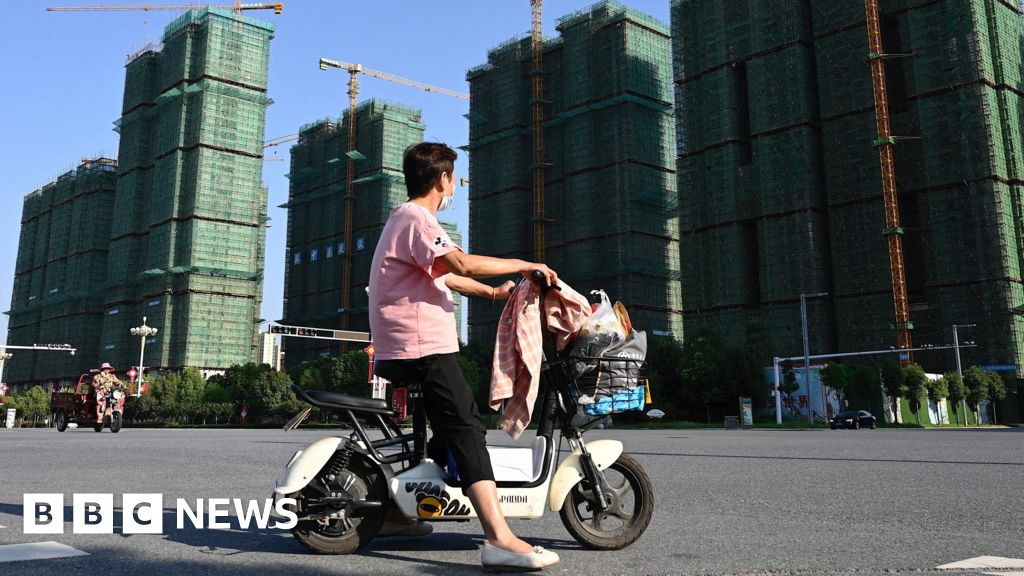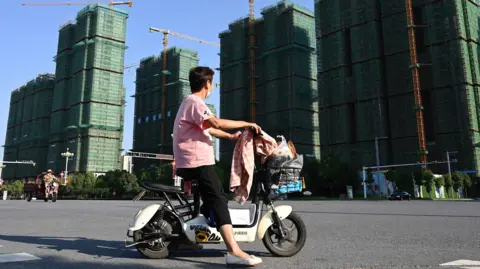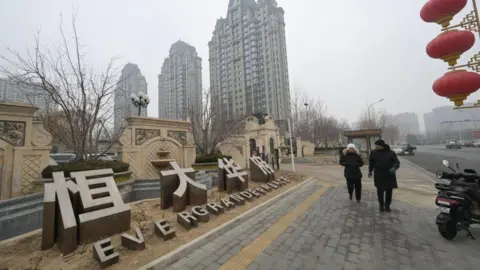Business
Evergrande: Chinese property giant delisted after spectacular fall

Business reporter, BBC News
 AFP via Getty Images
AFP via Getty ImagesChinese property giant Evergrande’s shares were taken off the Hong Kong stock market on Monday after more than a decade and a half of trading.
It marks a grim milestone for what was once China’s biggest real estate firm, with a stock market valuation of more than $50bn (£37.1bn). That was before its spectacular collapse under the weight of the huge debts that had powered its meteoric rise.
Experts say the delisting was both inevitable and final.
“Once delisted, there is no coming back,” says Dan Wang, China director at political risk consultancy Eurasia Group.
Evergrande is now best-known for its part in a crisis that has for years dragged on the world’s second-largest economy.
What happened to Evergrande?
Just a few years ago Evergrande Group was a shining example of China’s economic miracle.
Its founder and chairman Hui Ka Yan rose from humble beginnings in rural China to top the Forbes list of Asia’s wealthiest people in 2017.
His fortune has since plummeted from an estimated $45bn in 2017 to less than a billion, his fall from grace as extraordinary as his company’s.
In March 2024, Mr Hui was fined $6.5m and banned from China’s capital market for life for his company overstating its revenue by $78bn.
Liquidators are also exploring whether they can recover cash for creditors from Mr Hui’s personal property.
At the time of its collapse, Evergrande had some 1,300 projects under development in 280 cities across China.
The sprawling empire also included an electric carmaker and China’s most successful football team, Guangzhou FC, which was kicked out of the football league earlier this year after failing to pay off enough of its debts.
 AFP via Getty Images
AFP via Getty ImagesEvergrande was built on $300bn (£222bn) of borrowed money, earning it the unenviable title of the world’s most indebted property developer.
The rot set in after Beijing brought in new rules in 2020 to control the amount big developers could borrow.
The new measures led Evergrande to offer its properties at major discounts to ensure money was coming in to keep the business afloat.
Struggling to meet interest payments, the firm soon defaulted on some of its overseas debts.
After years of legal wrangling, the Hong Kong High Court ordered the company to be wound up in January 2024.
Evergrande’s shares had been under threat of delisting ever since because they were suspended from trading after the court order.
By that point the crisis engulfing the firm had wiped more than 99% from its stock market valuation.
The liquidation order came after the company was unable to offer a workable plan to shed billions of dollars of overseas liabilities.
Earlier this month, liquidators revealed that Evergrande’s debts currently stand at $45bn and that it had so far sold just $255m of assets. They also said they believe a complete overhaul of the business “will prove out of reach”.
The “delisting now is surely symbolic but it’s such a milestone,” Ms Wang says.
All that remains is which creditors are paid and how much they can get in the bankruptcy process, says Professor Shitong Qiao from Duke University.
The next liquidation hearing is due to take place in September.
How was China’s economy impacted?
China is facing a number of major problems, including US President Donald Trump’s tariffs, high local government debt, weak consumer spending, unemployment and an ageing population.
But experts say Evergrande’s collapse, along with the serious problems faced by other developers, has hit the country hardest.
“The property slump has been the biggest drag on the economy, and the ultimate reason why consumption is suppressed,” Ms Wang says.
 Getty Images
Getty ImagesThis is particularly problematic as the industry accounted for about a third of the Chinese economy and was a major source of income for local governments.
“I don’t think China has found a viable alternative to support its economy at a similar scale,” Professor Qiao says.
The property crisis has led to “massive layoffs” by heavily-indebted developers, Jackson Chan from financial markets research platform Bondsupermart says.
And many real estate industry employees that kept their jobs have seen big pay cuts, he adds.
The crisis is also having a major impact on many households as they tend to put their savings into property.
With housing prices dropping by at least 30%, many Chinese families have seen their savings fall in value, says Alicia Garcia-Herrero, chief economist for Asia Pacific at French bank Natixis.
This means they are less likely to spend and invest, she adds.
In response, Beijing has announced a raft of initiatives aimed at reviving the housing market, stimulating consumer spending and boosting the wider economy.
They range from measures to help new home owners and support the stock market to incentives to buy electric cars and household goods.
Despite the hundreds of billions of dollars Beijing has poured into the economy, China’s once-blistering growth has eased to “around 5%”.
While most Western countries would be more than happy with that, it’s slow for a country that saw growth of more than 10% a year as recently as 2010.
Is the property crisis over yet?
In short, probably not.
Even as Evergrande continues to grab headlines, several other Chinese property firms are still facing major challenges.
Earlier this month, China South City Holdings was handed a winding up order by Hong Kong’s High Court, making it the biggest developer to be forced into liquidation since Evergrande.
Meanwhile, rival real estate giant Country Garden is still trying to secure a deal with its creditors to write off more than $14bn of outstanding foreign debt.
After a series of postponements, its next High Court liquidation hearing in Hong Kong is due to take place in January 2026.
“The whole property sector has been in trouble. More Chinese property firms will collapse,” Professor Qiao says.
 AFP via Getty Images
AFP via Getty ImagesWhile the Chinese government has taken a number of measures to help shore up the property market and support the economy as a whole it has not swooped in to directly bail out developers.
Mr Chan says these initiatives seem to be having a positive impact on the property market: “We think the bottom [has been reached] and it should be in a slow recovery. However, we probably don’t expect the recovery to be very strong.”
Wall Street investment giant Goldman Sachs warned in June that property prices in China will continue to fall until 2027.
Ms Wang agrees, and estimates that China’s stricken property market will “hit the bottom” in around two years when demand finally catches up with supply.
But Ms Garcia-Herrero puts it in starker terms: “there is no real light at the end of the tunnel.”
Beijing has sent a “clear message on its intention of not bailing out the housing sector,” Ms Wang adds.
The Chinese government has been careful to avoid the kind of measures that could encourage further risky behaviour by an already heavily indebted industry.
And while in the boom times, the property market was a key driver of China’s economic growth, the ruling Communist Party’s priorities now lie elsewhere.
President Xi Jinping is more focussed on high-tech industries like renewable energy, electric cars and robotics.
As Ms Wang puts it, “China is in a deep transition to a new age of development.”
Business
Stock Market Live Updates: Sensex, Nifty Hit Record Highs; Bank Nifty Climbs 60,000 For The First Time

Stock Market News Live Updates: Indian equity benchmarks opened with a strong gap-up on Monday, December 1, touching fresh record highs, buoyed by a sharp acceleration in Q2FY26 GDP growth to a six-quarter peak of 8.2%. Positive cues from Asian markets further lifted investor sentiment.
The BSE Sensex was trading at 85,994, up 288 points or 0.34%, after touching an all-time high of 86,159 in early deals. The Nifty 50 stood at 26,290, higher by 87 points or 0.33%, after scaling a record intraday high of 26,325.8.
Broader markets also saw gains, with the Midcap index rising 0.27% and the Smallcap index advancing 0.52%.
On the sectoral front, the Nifty Bank hit a historic milestone by crossing the 60,000 mark for the first time, gaining 0.4% to touch a fresh peak of 60,114.05.
Meanwhile, the Metal and PSU Bank indices climbed 0.8% each in early trade.
Global cues
Asia-Pacific markets were mostly lower on Monday as traders assessed fresh Chinese manufacturing data and increasingly priced in the likelihood of a US Federal Reserve rate cut later this month.
According to the CME FedWatch Tool, markets are now assigning an 87.4 per cent probability to a rate cut at the Fed’s December 10 meeting.
China’s factory activity unexpectedly slipped back into contraction in November, with the RatingDog China General Manufacturing PMI by S&P Global easing to 49.9, below expectations of 50.5, as weak domestic demand persisted.
Japan’s Nikkei 225 slipped 1.6 per cent, while the broader Topix declined 0.86 per cent. In South Korea, the Kospi dropped 0.30 per cent and Australia’s S&P/ASX 200 was down 0.31 per cent.
US stock futures were steady in early Asian trade after a positive week on Wall Street. On Friday, in a shortened post-Thanksgiving session, the Nasdaq Composite climbed 0.65 per cent to 23,365.69, its fifth consecutive day of gains.
The S&P 500 rose 0.54 per cent to 6,849.09, while the Dow Jones Industrial Average added 289.30 points, or 0.61 per cent, to close at 47,716.42.
Business
South Korea: Online retail giant Coupang hit by massive data leak

Osmond ChiaBusiness reporter
 Getty Images
Getty ImagesSouth Korea’s largest online retailer, Coupang, has apologised for a massive data breach potentially involving nearly 34 million local customer accounts.
The country’s internet authority said that it is investigating the breach and that details from the millions of accounts have likely been exposed.
Coupang is often described as South Korea’s equivalent of Amazon.com. The breach marks the latest in a series of data leaks at major firms in the country, including its telecommunications giant, SK Telecom.
Coupang told the BBC it became aware of the unauthorised access of personal data of about 4,500 customer accounts on 18 November and immediately reported it to the authorities.
But later checks found that some 33.7 million customer accounts – all in South Korea – were likely exposed, said Coupang, adding that the breach is believed to have begun as early as June through a server based overseas.
The exposed data is limited to name, email address, phone number, shipping address and some order histories, Coupang said.
No credit card information or login credentials were leaked. Those details remain securely protected and no action is required from Coupang users at this point, the firm added.
The number of accounts affected by the incident represents more than half of South Korea’s roughly-52 million population.
Coupang, which is founded in South Korea and headquartered in the US, said recently that it had nearly 25 million active users.
Coupang apologised to its customers and warned them to stay alert to scams impersonating the company.
The firm did not give details on who is behind the breach.
South Korean media outlets reported on Sunday that a former Coupang employee from China was suspected of being behind the breach.
The authorities are assessing the scale of the breach as well as whether Coupang had broken any data protection safety rules, South Korea’s Ministry of Science and ICT said in a statement.
“As the breach involves the contact details and addresses of a large number of citizens, the Commission plans to conduct a swift investigation and impose strict sanctions if it finds a violation of the duty to implement safety measures under the Protection Act.”
The incident marks the latest in a series of breaches affecting major South Korean companies this year, despite the country’s reputation for stringent data privacy rules.
SK Telecom, South Korea’s largest mobile operator, was fined nearly $100m (£76m) over a data breach involving more than 20 million subscribers.
In September, Lotte Cards also said the data of nearly three million customers was leaked after a cyber-attack on the credit card firm.
Business
Agency workers covering for Birmingham bin strikers to join picket lines

Agency workers hired to cover Birmingham bin strikers will join them on picket lines on Monday, a union has said.
A rally will be held by Unite The Union at Smithfield Depot on Pershore Street, Birmingham, on Monday morning to mark the first day of strike action by agency refuse workers.
Unite said the Job & Talent agency workers had voted in favour of strike action “over bullying, harassment and the threat of blacklisting at the council’s refuse department two weeks ago”.
The union said the number of agency workers who will join the strike action is “growing daily”.
Strikes by directly-employed bin workers, which have been running since January, could continue beyond May’s local elections.
The directly-employed bin workers voted in favour of extending their industrial action mandate earlier this month.
Unite general secretary Sharon Graham said: “Birmingham council will only resolve this dispute when it stops the appalling treatment of its workforce.
“Agency workers have now joined with directly-employed staff to stand up against the massive injustices done to them.
“Instead of wasting millions more of council taxpayers’ money fighting a dispute it could settle justly for a fraction of the cost, the council needs to return to talks with Unite and put forward a fair deal for all bin workers.
“Strikes will not end until it does.”
-

 Sports1 week ago
Sports1 week agoWATCH: Ronaldo scores spectacular bicycle kick
-

 Entertainment1 week ago
Entertainment1 week agoWelcome to Derry’ episode 5 delivers shocking twist
-

 Politics1 week ago
Politics1 week agoWashington and Kyiv Stress Any Peace Deal Must Fully Respect Ukraine’s Sovereignty
-

 Business1 week ago
Business1 week agoKey economic data and trends that will shape Rachel Reeves’ Budget
-

 Tech6 days ago
Tech6 days agoWake Up—the Best Black Friday Mattress Sales Are Here
-

 Fashion7 days ago
Fashion7 days agoCanada’s Lululemon unveils team Canada kit for Milano Cortina 2026
-

 Tech6 days ago
Tech6 days agoThe Alienware Aurora Gaming Desktop Punches Above Its Weight
-

 Politics1 week ago
Politics1 week ago53,000 Sikhs vote in Ottawa Khalistan Referendum amid Carney-Modi trade talks scrutiny






